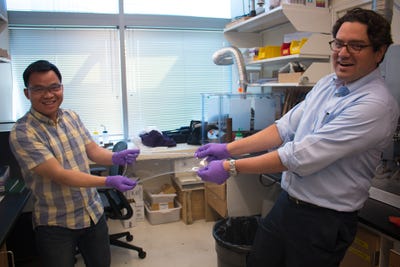August 9, 2017
Researchers from MIT created hydrogel-based capsules that can reside in the GI tract for up to nine days while releasing its medication -- enabling more complex drug dose regimens.
Kristopher Sturgis

Jinyao Liu, left, and Giovanni Traverso, researchers at MIT and Brigham and Women's Hospital, developed a new set of hydrogel-based drug delivery materials designed to ensure patients receive their full course of treatment.
These days when it comes to drug delivery, one of the biggest challenges is making sure patients actually stick with the full course of treatment prescribed by their doctor. With almost half of all medications for chronic diseases not taken as prescribed, researchers from MIT are now looking toward triggerable hydrogel-based capsules that can reside in the body and slowly release drugs over time, making it easier for patients to receive the complete dosage prescribed by a doctor.
The new drug delivery materials, designed by researchers at MIT and Brigham and Women's Hospital, were created to reside inside the stomach days at a time while they slowly release a calculated dose of medication, enabling patients to take a single pill just once a week or even once a month depending on the medication. Giovanni Traverso, a biomedical engineer at Brigham and Women's Hospital and co-senior author on the work, said the technology has already shown to be effective in early animal trials.
"We demonstrated the capacity for these gels to remain stable in the stomach of a pig for over one week," he said. "We also were able to demonstrate in a pig the ability to induce the gels dissolution, and the work we recently published is a first step towards developing triggerable tough hydrogels for drug delivery. They could certainly one day help simplify dosing regimens."
The group maintains that developing a capsule that can reside in the gastrointestinal tract, rather than quickly pass through the body has been no small task. The materials of the capsule must be able to withstand the corrosive and compressive forces of the stomach, and the size of the capsule must be small enough to swallow, but large enough to avoid being passed from the stomach to the intestines.
Traverso also says that the capsules must be designed with a self-destruct function, in the event that a patient has an allergic reaction or any unwelcome side effects to the drug being delivered. This was when the group began working with hydrogels with a high concentration of water, a trait that enables the capsules to swell when hydrated. This would allow patients to swallow a small, dehydrated hydrogel capsule that would swell upon entering the stomach, allow it to reside there for days at a time, releasing drugs or be passed through the system if necessary.
The idea of using polymer materials for stomach-based drug delivery is certainly gathering momentum, as more and more researchers explore the potential of ultra-long drug delivery capabilities. In 2015 Traverso and his colleagues were the first to develop a pH-responsive polymer gel that could withstand prolonged periods of time in the stomach -- a feat that certainly contributed to these new hydrogel-based capsules.
"We have been working on developing gastric resident systems over the past four years in collaboration with the Bill and Melinda Gates Foundation," Traverso said. "From the beginning, we have explored a range of approaches to this challenge, including the development of hydrogels that might help us achieve this. As we continue our work in this area, we aim to expand the data supporting the safety associated with systems like these and also evaluate a broader set of drugs for extended drug release."
As the group moves forward with their research, Traverso said the impact the technology could have on patient care could be rather significant. With safety and manufacturing studies on the horizon, he hopes that the technology could be ready for clinical use in a few years time.
"We are working hard to make it easier for patients to take their medications through a system that can reside safely in the stomach, and we hope one day we can achieve that goal," he said. "Capsules made of gels like these, we hope, will be ready for human evaluation in the coming three to five years, but before then we need to complete significant safety and manufacturing studies."
Kristopher Sturgis is a contributor to Qmed.
[Image credit: MIT]
About the Author(s)
You May Also Like


